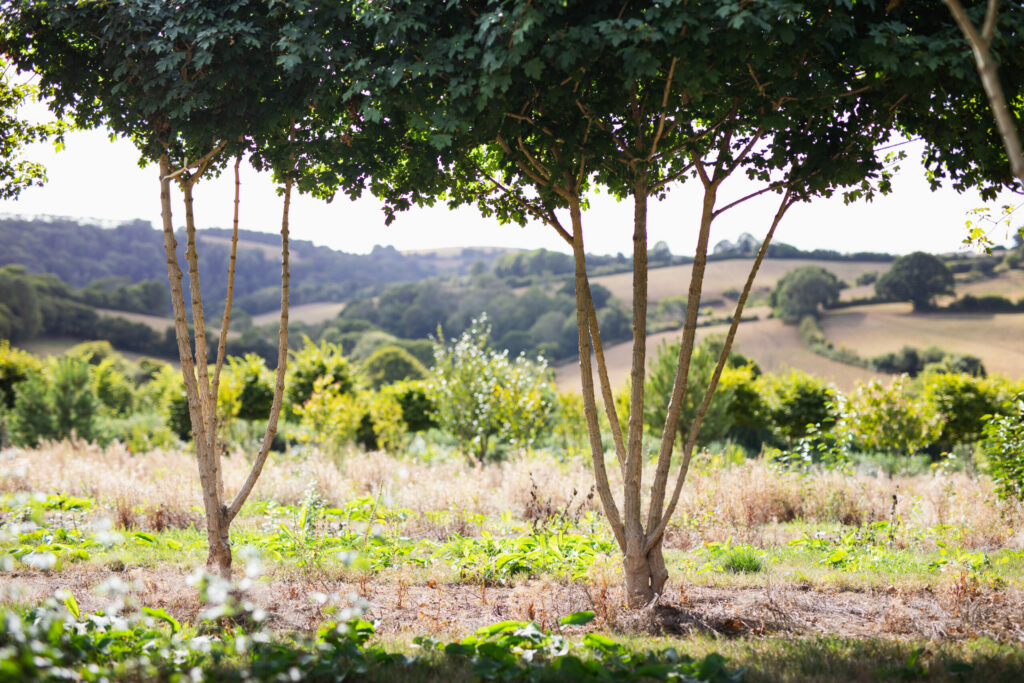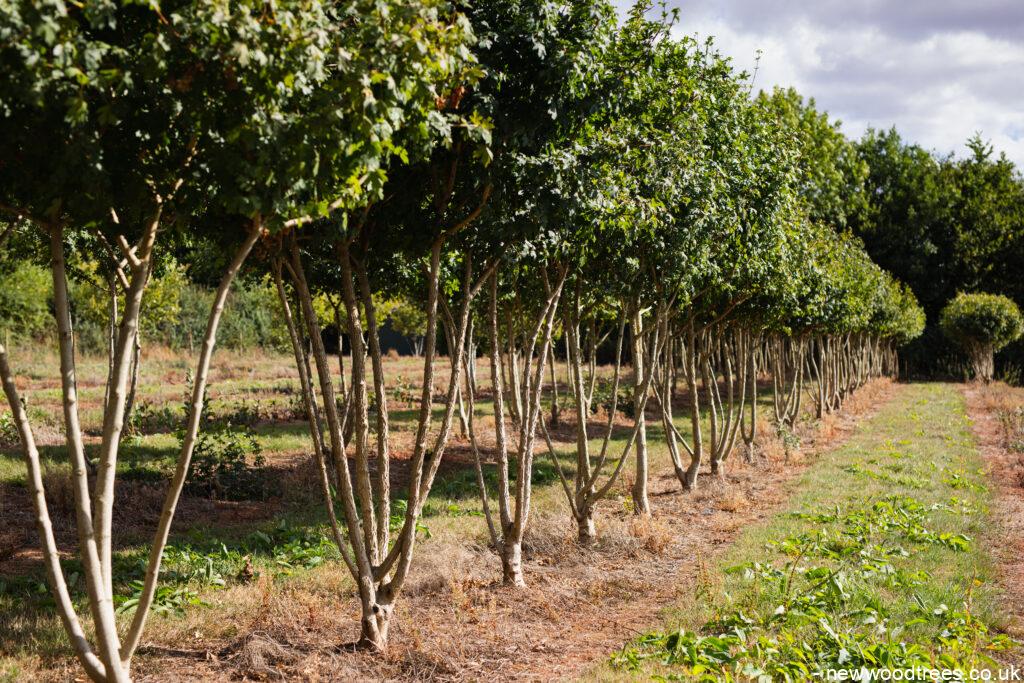Trees are growing in popularity, not least because of the multiple benefits they bring to any outside space. Multi-stem trees have emerged as champions in urban landscapes, managed forests, and gardens.
These unique specimens, characterised by multiple stems emerging from the ground, offer many benefits that make them an invaluable addition to any green space. In this article, we will explore the advantages of multi-stem trees, shedding light on their ecological, aesthetic, and practical contributions.
- Enhanced Carbon Sequestration

Multi-stem trees play a pivotal role in alleviating climate change through their extraordinary capability for carbon capture. This procedure initiates photosynthesis, wherein trees uptake carbon dioxide from the atmosphere. Via an intricate biochemical process, carbon is transformed into glucose (sugar), which functions as an energy source for the tree while liberating oxygen into the atmosphere.
In multi-stem trees, their advantage resides in their numerous stems and denser canopy. This means they have an enormous expanse for photosynthesis to take place. They generally boast a greater abundance of leaves and branches, heightening the overall potential for carbon assimilation. This escalated proficiency in sequestering carbon renders them invaluable in combating climate change.
- Biodiversity Hotspots
The intricate structure of multi-stemmed trees creates microhabitats ideal for diverse wildlife. The assorted crevices and recesses in trunks and boughs provide cover, breeding grounds, and secluded spots for countless species. Birds frequently construct their nests in the branches, whereas insects discover sanctuary in the bark. Small mammals such as squirrels and bats might also avail themselves of these areas.
In metropolitan settings, where verdant areas are restricted, multi-stem trees evolve into vital sanctuaries for wildlife. They offer a haven amidst the urban expanse, bolstering local biodiversity and fostering a more robust, harmonised ecosystem.
- Aesthetically Pleasing
The visual allure of multi-stem trees, including the captivating multi-stem birch, is evidence of their unique and beautiful appearance. In contrast to single-stem trees, multi-stemmed trees display a branching design that initiates near the ground, giving rise to numerous stems.
Additionally, multiple stems impart a feeling of intricacy and variety to the tree’s shape. Each stem extends outward, constructing a network of stems and boughs that interlace in a visually absorbing manner. This elaborate arrangement captivates the interest of casual onlookers and tree specialists alike. It beckons for a more intimate examination, drawing individuals to appreciate the tree’s innate architecture.
- Adaptability and Resilience
One of the outstanding attributes of multi-stem trees is their capacity to prosper in demanding circumstances. They have demonstrated an admirable resistance to diverse pressures, encompassing substandard soil conditions and metropolitan contamination. Their flexibility enables them to bloom when alternative trees face difficulties. This renders them especially fitting for city settings, where soil quality and air conditions may be less than optimal.
- Versatile Use in Design

Multi-stem trees have tremendous versatility when it comes to garden design. Their development pattern, which leans towards being more condensed when contrasted with single-stem trees, permits inventive uses in landscaping. They can be trimmed and sculpted to accommodate a broad spectrum of objectives. For example, they can be employed to restrict areas, establish seclusion barriers, or even serve as wind buffers, amplifying the effectiveness of outdoor spaces.
- Cost-Effective
Multi-stem trees extend practical advantages in relation to economic viability. Compared with single-stem trees, their cost effectiveness makes them appealing for extensive planting. Moreover, they generally necessitate fewer reinforcement frameworks, as their numerous stems offer inherent steadiness. Consequently, the total investment required for establishing and maintaining a multi-stem tree populace can be notably reduced.
This diminished need for reinforcement frameworks reduces costs and streamlines the planting procedure, hastening the formation of a flourishing garden. Additionally, the natural stability of numerous stems bestows multi-stem trees a robust resilience to unfavourable weather conditions, further reducing expenses linked with potential storm damage or tree replacement.
- Reduced Maintenance Requirements

Thanks to their robust constitution and versatility, multi-stem trees typically need less continual upkeep when compared to their single-stem counterparts. They possess an innate resistance to wind damage, given that the presence of numerous stems offers supplementary support. Furthermore, they tend to be less vulnerable to illnesses, diminishing the necessity for expensive treatments or interventions.
This decreases long-term maintenance expenses, making them sensible choices for sustainable landscaping and urban forestry ventures. Furthermore, the sturdy framework of multi-stem trees implies they are less prone to experiencing structural problems or needing corrective pruning, further decreasing maintenance exertions.
Their adaptability to varied environmental conditions also means they thrive with minimal interference, enabling a more hands-off strategy to care. This preserves time and resources and harmonises with sustainable landscaping principles, encouraging a self-sustaining ecosystem that thrives over time.
If ever you need advice or tips on the maintenance of multi-stemmed trees, search our blogs for advice or get in touch with us.
- Soil Stabilisation and Erosion Control
Multi-stem trees have a widespread and intricate root system stretching horizontally and vertically through the earth. The interweaving roots of numerous stems collaborate to fasten soil particles together, forming a more secure and condensed base. This characteristic is especially pivotal in regions distinguished by elevated or inclined terrains, where erosion can present a substantial hazard to soil structure.
In fact, multi-stem trees can be a potent natural resolution in areas predisposed to landslides or soil deterioration. Their sturdy root networks serve as anchors, clutching the soil in position and impeding it from being swept away amid intense downpours or turbulent atmospheric conditions. This not only shields the immediate vicinity but also contributes to the overall well-being and steadiness of the ecosystem.
- Noise Reduction and Privacy
The thick canopy of multi-stem trees provides an efficient natural obstacle against sound pollution. The leaves, branches, and stems collectively soak up and redirect sound waves, lessening the impact of background noise from sources like traffic, construction, and other urban activities. This noise-mitigating effect can notably enrich the standard of life for residents in urban environments, creating more serene and calm living spaces.
Furthermore, when strategically planted, multi-stem trees can offer an invaluable source of seclusion. By establishing a visual partition, they shield homes, outdoor spaces, and properties from direct view, affording a feeling of privacy and tranquillity. This privacy-boosting feature is especially valued in densely inhabited areas or locales where proximity to neighbours is a factor to consider.
- Microclimate Regulation
Multi-stem trees perform a crucial function in regulating local micro-environments. Their extensive canopies offer shelter, which aids in decreasing surrounding temperatures, particularly during sweltering summer months. This shading influence diminishes the heat island phenomenon frequently encountered in urban zones, where large stretches of concrete and asphalt can lead to escalated temperatures.
Moreover, in winter, multi-stem trees serve as efficient wind breaks, particularly evergreens. Their thick foliage and numerous stems shape a natural barricade that curtails heat dissipation from nearby structures. This creates more pleasant and energy-efficient micro-environments, ultimately curbing heating expenses and energy usage.
- Educational and Recreational Value
The complex structure and ecological interactions of multi-stem trees make them invaluable educational resources. They afford practical learning opportunities for students of all ages, nurturing a profound comprehension of ecology, biodiversity, and the complex interrelations within ecosystems.
Multi-stem trees function as lecture halls for educational schemes and initiatives centred on environmental preservation and sustainability. Witnessing the assorted range of wildlife that discovers sanctuary in these trees and understanding their function in the ecosystem is a potent method to instil a feeling of environmental guardianship in subsequent generations.
Furthermore, multi-stem trees offer sheltered zones in recreational areas perfect for unwinding, outings, and open-air pursuits. Their presence heightens the functionality and gratification of parks, gardens, and other communal spaces, adding to the all-encompassing well-being of communities.
- Cultural and Historical Significance
Specific varieties of multi-stem trees possess profound cultural or historical importance. They might be revered for their representation in diverse cultures or prominently showcased in mythology, artistic expressions, and customary observances. Safeguarding and integrating these trees into landscapes pays tribute to the cultural legacy and reinforces the tie between societies and their origins.
These trees transform into breathing embodiments of cultural distinctiveness and can function as influential benchmarks for communities, bestowing a sense of unbroken tradition and legacy across the ages.
- Drought Tolerance
Many types of multi-stem trees show a notable resilience to dry conditions. Their root systems are proficient at efficiently using water reserves, allowing them to thrive even in regions with limited rainfall or periods of water scarcity. This drought resilience is valuable for areas facing water conservation challenges, making multi-stem trees an excellent choice for environmentally friendly landscaping and forestry initiatives.
- Habitat for Beneficial Insects
Multi-stem trees frequently act as lively ecosystems in their capacity. They accommodate various creepy crawlies, encompassing vital pollinators like bees and butterflies. These bugs play a pivotal function in bolstering local ecosystems and agricultural zones, aiding in the pollination of flora and the yield of food crops.
By furnishing a dwelling for advantageous insects, multi-stem trees add to ecosystems’ comprehensive well-being and tenacity, nurturing diversity and sustaining balanced and flourishing natural surroundings.
Wrapping Up
Multi-stem trees are a blessing for both the city and the natural scenery. Their environmental offerings, visual charm, and functional benefits make them an indispensable resource in the quest for sustainable and robust surroundings.
As we confront the trials of a swiftly evolving climate and urban expansion, adopting the multi-stem movement is a stride towards a more verdant, fitter future. By incorporating these extraordinary trees into our environment, we pave the way for a balanced coexistence with nature, enjoying the numerous advantages they grant us.







